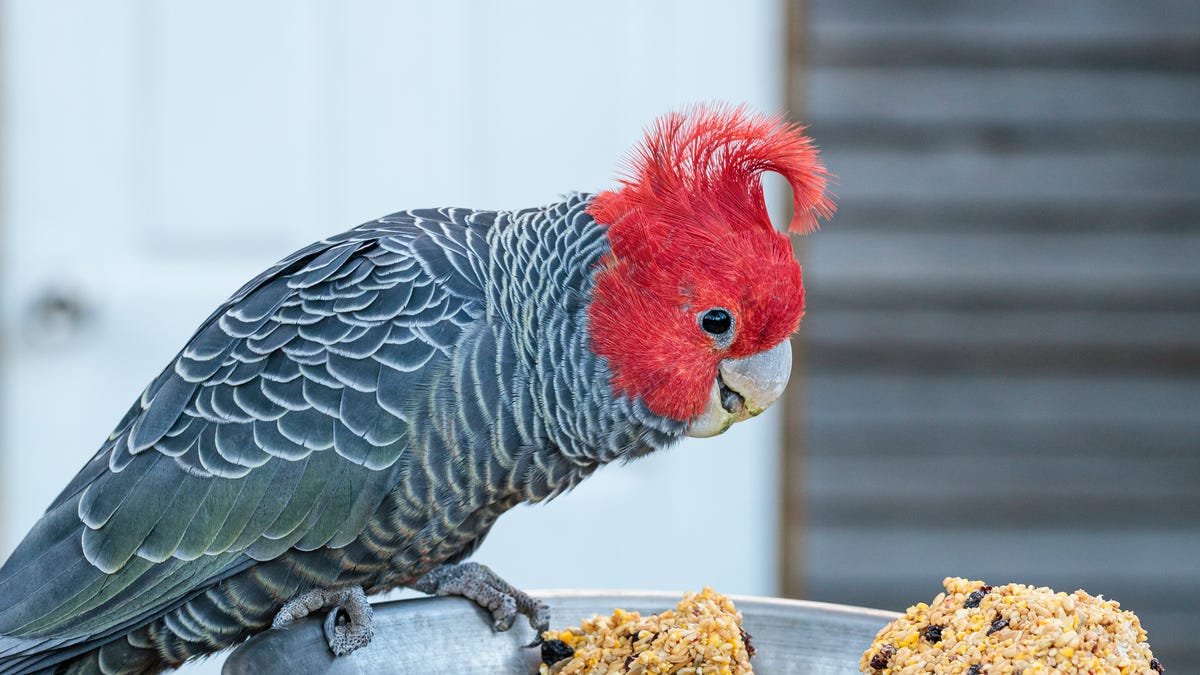Scientists concerned climate change is causing animals to 'shape-shift'
Wood mice have larger ears. Australian parrots have bulkier bills. And the shifts are happening very quickly, researchers say.

A male gang-gang cockatoo perched on a retaining wall. This type of bird is among the slew of species "shape-shifting" to adapt to warmer climates.
The climate crisis is sending natural selection into overdrive, a new study suggests, forcing animals to cope with rapidly warming temperatures by physically morphing, or "shape-shifting." That raises a piercing question: Can evolution keep up with the result of human-driven carbon emissions?
In the last 150 years, Australian parrots, such as gang-gang cockatoos and red-rumped parrots, have shown up to a 10% average increase in bill size alongside rising temperatures in their natural habitats, according to research published Tuesday in the journal Trends in Ecology & Evolution.
"It's alarming that we are seeing these responses so early on in the climate crisis," said study author Sara Ryding, a researcher in the School of Life and Environmental Sciences at Deakin University in Australia. "We don't know if they'll be able to keep up as the crisis worsens."
The fluffy parrots streaked with bright colors aren't the only victims of a warmer world. Several other species of birds in North America and Australia have seen an increase in bill size, wood mice have bigger ears, and some bats are flaunting an upgraded, larger set of wings.
Those larger appendages are expected to help the animals manage hot weather because they offer a greater surface area for releasing body heat. "This is not necessarily an increase that's visible to the naked eye," Ryding noted, "but it's still functionally important."
Though evolution has occurred since the beginning of life on Earth, Ryding worries that right now it's happening far too quickly.
"I don't want the takeaway to be that, 'Oh, animals are evolving in response to climate change, that means they'll be fine,' because that simply isn't true," she said.
The team's study, which scoured through tons of already published papers to compare trends in animal shape-shifting against climate change, recognized that the rampant adaptations are happening relatively early along the projected timeline of the climate crisis.
That timeline doesn't taper off for a while.
The Intergovernmental Panel on Climate Change already calls many countries' previous goal of limiting global warming in the next decades to 1.5 degrees, or even 2 degrees, as "beyond reach." That's unless there are "immediate, rapid and large-scale reductions in greenhouse gas emissions," reads the group's report from August, which the panel deems a "reality check."
"Climatic changes are happening at a faster rate than ever before," Ryding said. "Although evolutionary changes can be a slow process, taking thousands -- or more -- years, we also know that strong selection can drive faster evolutionary change."
By strong selection, Ryding is referring to the intensity with which natural selection occurs. If only one in 10 members of a species can survive in a warm climate due to their having a larger appendage, the other nine won't live long enough to pass their genes onto the next generation.
That's why we're seeing new cohorts of species with bulkier appendages riding the trajectory of global warming.
"Seeing just how widespread this phenomenon is across geographic scales and across a broad range of animals -- the unifying factor that we find is climate change," Ryding said.
The correlation makes sense, because of a theory first developed in 1877 by American zoologist and ornithologist Joel Asaph Allen. It basically states that animals living in warmer climates will have larger, longer appendages than those in colder areas.
"Animals can let go of excess body heat through their appendages, so larger appendages allow them to let go of even more excess body heat, which is beneficial as the climate warms," Ryding explained.
Allen's rule has been widely studied by scientists, including in a paper from 2020 that aims to establish its benefit as a predictive tool for climate change outcomes. However, the sheer coverage of Ryding's work solidifies the phenomenon of expedited evolution as a far-reaching issue.
"I hope that these findings really highlight how climate change is impacting animals," Ryding said, "and how important it is that we work to reduce our emissions and avoid the climate crisis as much as possible."

